Shopping electric side-by-sides in 2025? Start here. For full-size off-road work, choose the Polaris RANGER XP Kinetic (up to ~80-mile Ultimate). For lower entry cost, Landmaster AMP (lithium) and Hisun Sector E1 cover light property duty.
Turf/commercial fleets should look at Greenworks CU800 or John Deere Gator TE. Use the table below to compare seats, tow, bed, range, and MSRP*. Then jump to Editor’s Picks by use case.
Lithium generally delivers more range and faster charging; lead-acid lowers upfront price. Where the manufacturer publishes a US MSRP, we show “From $… ” (e.g., Polaris Pro XD Kinetic — From $30,394; Greenworks CU800 — From $28,999; Landmaster AMP — From $16,999; Hisun Sector E1 — From $11,999; Kandi Cowboy e10K — From $15,999); for all others, use Check dealer.
Key Takeaways
- Workhorse pick: Polaris RANGER XP Kinetic — 2,500-lb tow / 1,250-lb bed, ~45–80-mi range (pack-dependent).
- Lower entry cost: Landmaster AMP (lithium) and Hisun Sector E1 (lead-acid) — both rated 1,500-lb tow, 500-lb bed.
- Turf/commercial: Greenworks CU800 (up to 75-mi) or John Deere Gator TE (quiet, turf-safe).
- Buying tip: Prefer lithium for range/charge speed; use “Check dealer” for current pricing; match tow/bed/range to your job.
Best Electric UTV (2025): Top Electric Utility Vehicles & Side-by-Sides
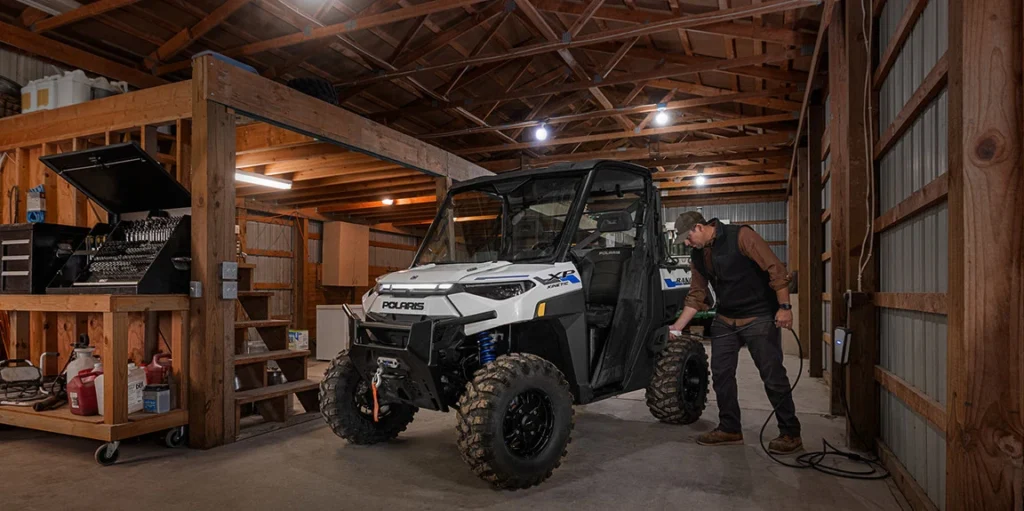
- Polaris RANGER XP Kinetic
- Landmaster AMP
- Hisun Sector E1
- Polaris Pro XD Kinetic
- Greenworks CU800
- John Deere Gator TE
- Kandi Cowboy e10K
- TRACKER Off Road EV iS
- Cushman Hauler Pro
- Club Car Carryall 700
Quick Comparison (2025)
| Model (2025) | Use / Segment | Seats | Tow (lb) | Bed (lb) | Range (mi) | MSRP |
|---|---|---|---|---|---|---|
| Polaris RANGER XP Kinetic (Prem/Ult) | Off-road work (full-size) | 3 | 2,500 | 1,250 | 45–80 | Check dealer |
| Polaris Pro XD Kinetic | Commercial jobsite EV | 2 | 2,500 | 1,250 | ~45 | From $30,394* |
| Landmaster AMP (4×4 Standard Cab) | Light work / property | 2 | 1,500 | 500 | up to ~50 | From $16,999* |
| Hisun Sector E1 | Budget utility | 2 | 1,500 | 500 | ~42 | Check dealer |
| Kandi Cowboy e10K | Budget AWD EV | 2 | 1,800 | 441 | up to ~60 | Check dealer |
| Greenworks CU800 | Turf / commercial | 2 | 1,500 | 550 | up to ~75 | $28,999* |
| John Deere Gator TE (4×2) | Turf utility (quiet) | 2 | 600 | 600 | — | Check dealer |
| Cushman Hauler Pro (ELiTE) | Grounds / maintenance | 2 | 1,500 | 800 | 25–32 | Check dealer |
| Club Car Carryall 700 (Lithium) | Facilities / farm cargo | 2 | 1,500 | 1,000 | 20+ | Check dealer |
| TRACKER Off Road EV iS | Hunt / property cart | 4 | 1,000 | —** | up to 16 | Check dealer |
*Range figures are ideal-condition claims; expect lower in cold, heavy loads, or hilly terrain.
**EV iS has a rear deck/payload platform rather than a traditional dump bed.
Editor’s Picks
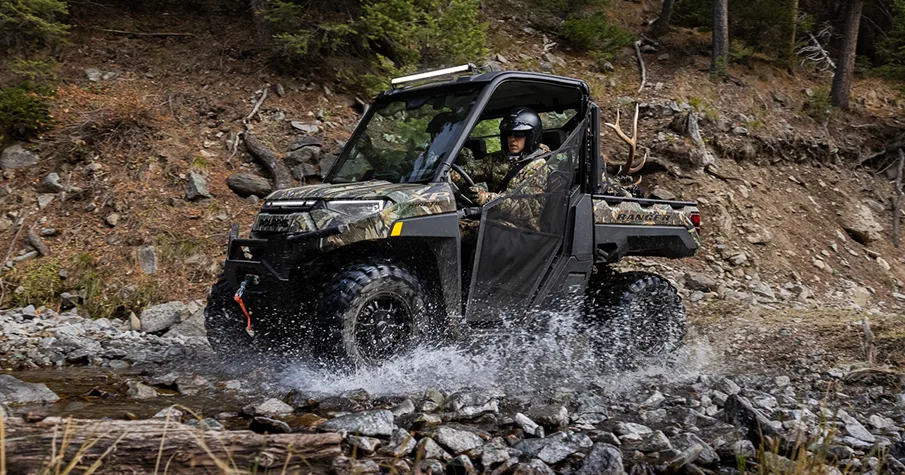
1. Polaris RANGER XP Kinetic (2025)
Who it’s for: Full-size off-road work and property use.
Spec chips: Seats 3 • Tow/Bed 2,500/1,250 lb • Range ~45–80 mi (by pack) • Price: Check dealer.
Why pick it: Class-leading electric work capacities with quiet torque.
Pros: Strong tow/bed; two battery options.
Cons: Premium price; L2 charging requires accessory.
Source: Polaris RANGER XP Kinetic specs page.
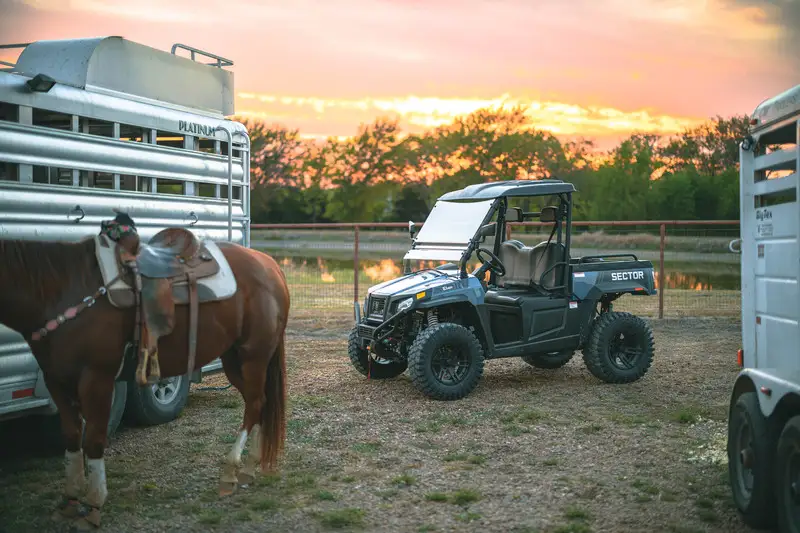
2. Landmaster AMP (2025)
Who it’s for: Light work and ranch/property duty at a lower entry price.
Spec chips: Seats 2 • Tow/Bed 1,500/500 lb • Range up to ~50 mi • Price: From $16,999 (OEM) or Check dealer
Why pick it: Simple ownership and good lithium value for daily chores.
Pros: Easy 120V home charging; U.S. brand.
Cons: Lighter-duty chassis vs full-size work rigs.
Source: Landmaster AMP page.
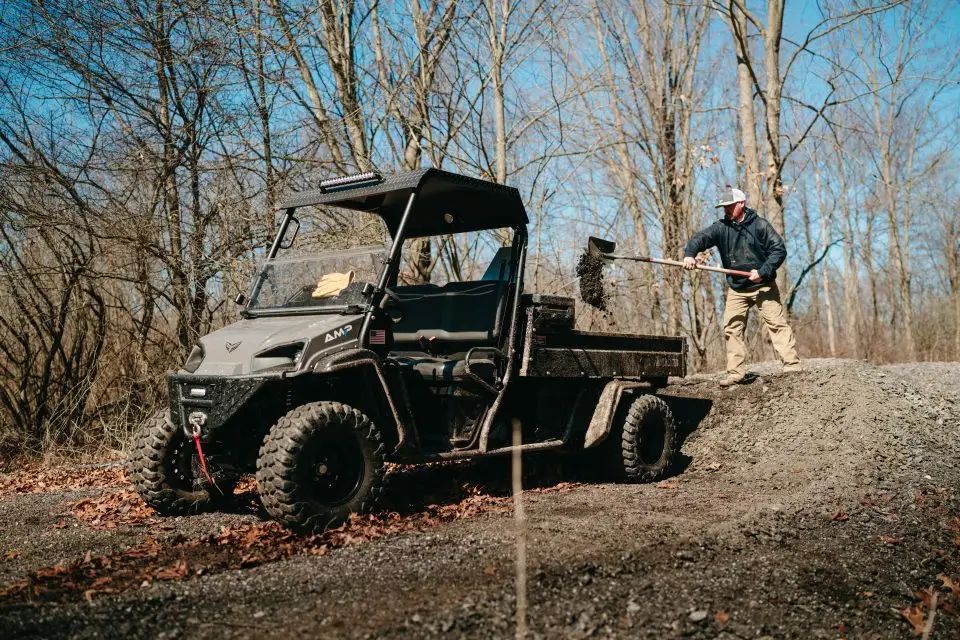
3. Hisun Sector E1 (2025)
Who it’s for: Budget electric utility buyers who still need tow capability.
Spec chips: Seats 2 • Tow/Bed 1,500/500 lb • Range ~42 mi • Price: Check dealer
Why pick it: Lowest new-EV entry price among utility-focused models.
Pros: Affordable; 1,500-lb tow.
Cons: Lead-acid battery; shorter range.
Source: Hisun Sector E1 page.
Full List blurbs
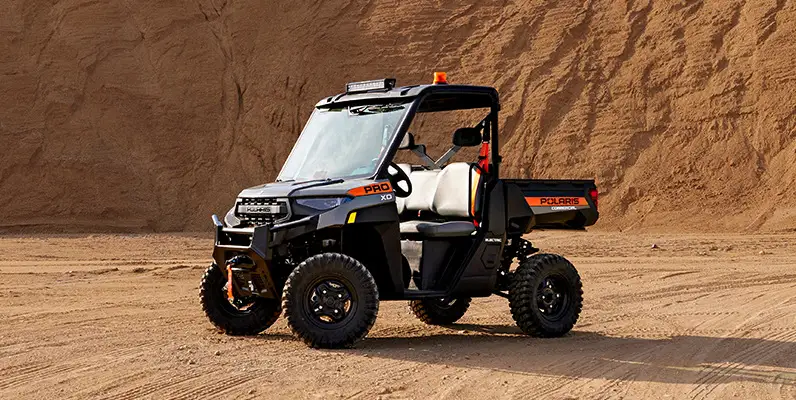
4. Polaris Pro XD Kinetic (2025)
Who it’s for: Commercial/fleet jobsites needing electric power and big box capacity.
Spec chips: Seats 2 • Tow/Bed 2,500/1,250 lb • Range ~45 mi • Price: From $30,394 (OEM) or Check dealer.
Why pick it: Commercial build, safety features, and fleet support.
Pros: Fleet-ready; L1/L2 mobile EVSE included.
Cons: 2-seat only; commercial-channel availability.
Source: Polaris Commercial Pro XD Kinetic page.
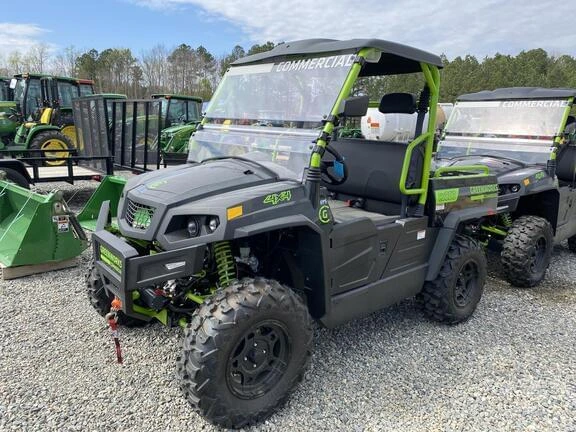
5. Greenworks CU800 (2025)
Who it’s for: Turf/grounds crews and campuses prioritizing long range.
Spec chips: Seats 2 • Tow/Bed 1,500/550 lb • Range up to ~75 mi • Price: $28,999 (OEM)
Why pick it: Longest quoted range in the turf/commercial group.
Pros: Strong range; commercial support.
Cons: Turf-biased; slower than sport UTVs.
Source: Greenworks Commercial CU800 page.
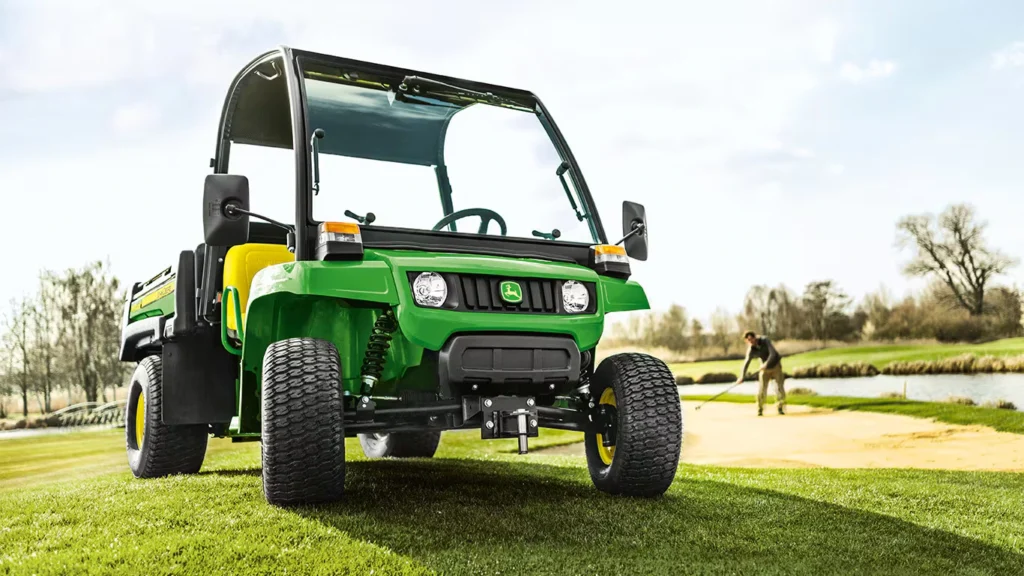
6. John Deere Gator TE (2025)
Who it’s for: Quiet, turf-safe work on campuses, resorts, and facilities.
Spec chips: Seats 2 • Tow/Bed 600/600 lb • Range — • Price: Check dealer
Why pick it: Proven fleet platform with huge parts/accessories ecosystem.
Pros: Quiet/turf-safe; simple 48V system.
Cons: 4×2 only; ~13 mph top speed.
Source: John Deere Gator TE page.
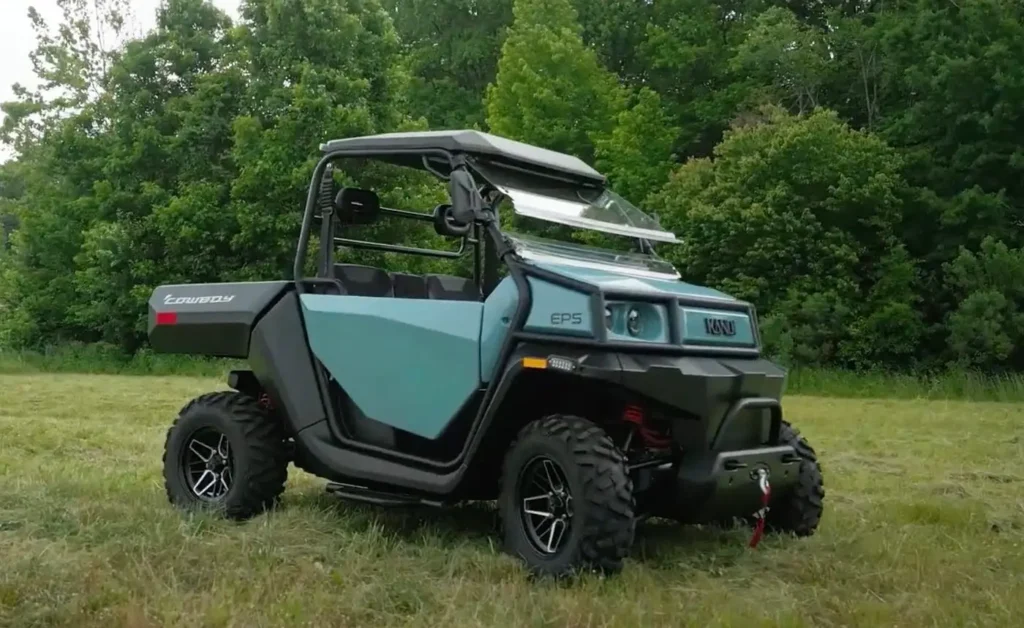
7. Kandi Cowboy e10K (2025)
Who it’s for: Budget shoppers wanting AWD with LFP battery chemistry.
Spec chips: Seats 2 • Tow/Bed 1,800/441 lb • Range up to ~60 mi • Price: Check dealer
Why pick it: Dual-motor AWD at an aggressive price point.
Pros: AWD; LFP battery.
Cons: Lower bed rating; dealer availability varies.
Source: Kandi Cowboy e10K page.
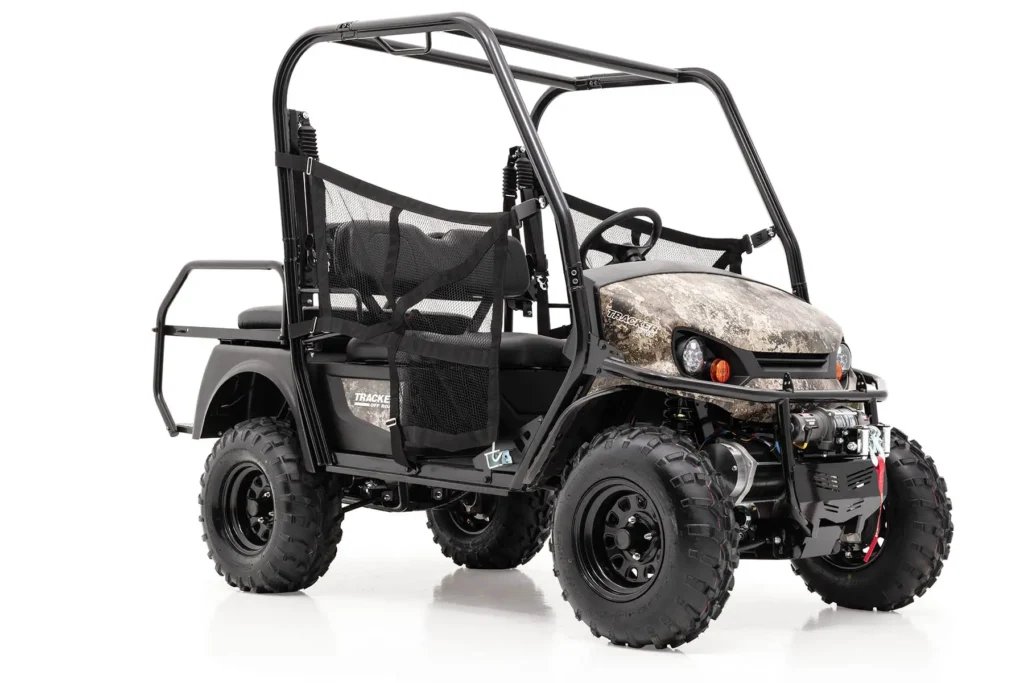
8. TRACKER Off Road EV iS (2025)
Who it’s for: Quiet hunting/property use with a convertible rear deck.
Spec chips: Seats 4 • Tow 1,000 lb • Bed — (deck/payload platform) • Range up to 16 mi • Price: Check dealer
Why pick it: Low noise and 16″ ground clearance for woods and trails.
Pros: Quiet; 4 seats; high clearance.
Cons: Shorter range; deck isn’t a dump bed.
Source: TRACKER Off Road EV iS page.
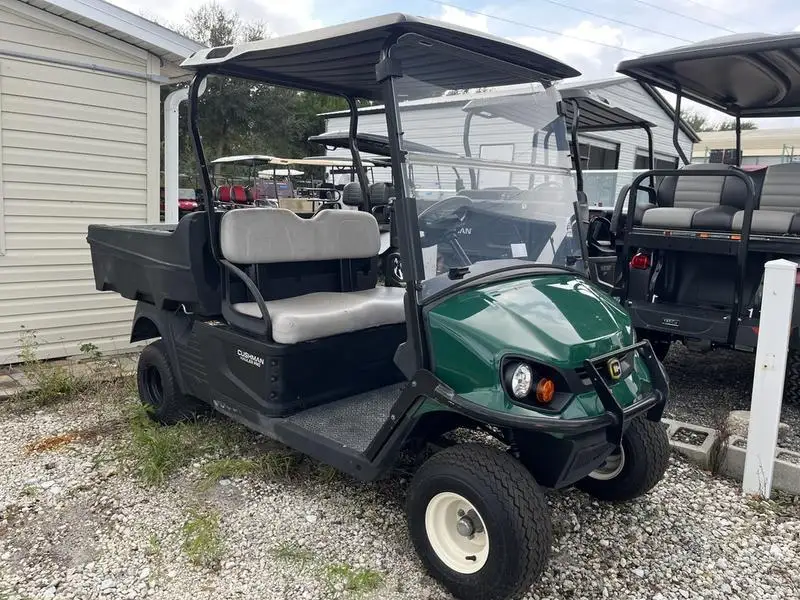
9. Cushman Hauler Pro (ELiTE) (2025)
Who it’s for: Grounds/maintenance teams needing a lithium work cart.
Spec chips: Seats 2 • Tow/Bed 1,500/800 lb • Range 25–32 mi • Price: Check dealer
Why pick it: ELiTE lithium system with strong grounds capacity.
Pros: Fleet-ready; reliable platform.
Cons: Not built for rough trail abuse.
Source: Cushman Hauler Pro page.
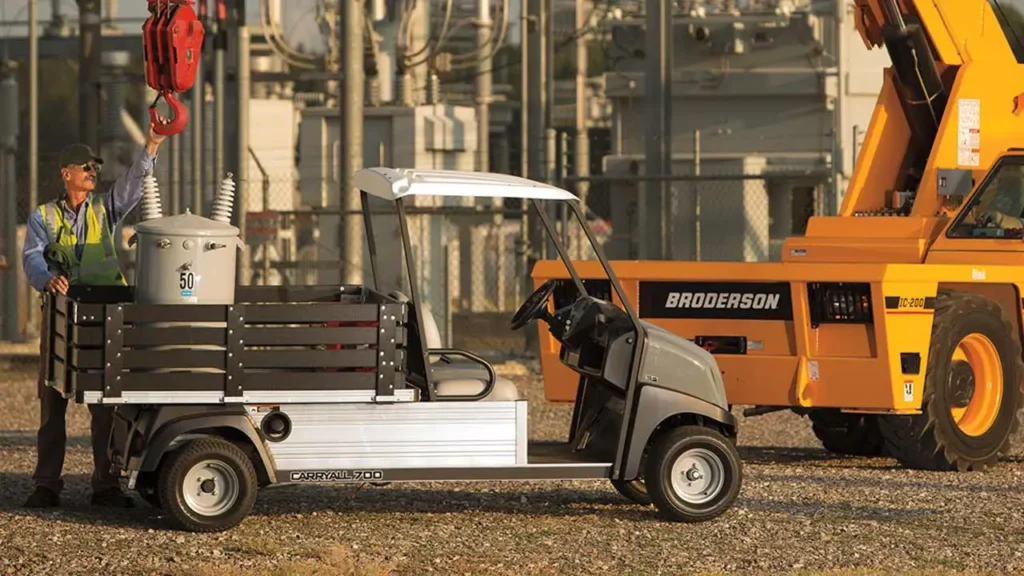
10. Club Car Carryall 700 (2025)
Who it’s for: Facilities and farms moving bulky loads on smoother terrain.
Spec chips: Seats 2 • Tow/Bed 1,500/1,000 lb • Range 20+ mi • Price: From $… or Check dealer
Why pick it: Big cargo box in a proven platform.
Pros: Large bed; strong utility.
Cons: Lower ground clearance; slower top speed.
Source: Club Car page.
Lithium vs Lead-Acid (what matters)
- Range & power: Lithium packs deliver more usable capacity and steadier power as state-of-charge drops. Lead-acid voltage sags as you work; expect shorter real-world range.
- Charge time: Lithium charges faster and tolerates partial charges well. Lead-acid prefers full charges and cool-downs; frequent partials shorten life.
- Lifespan: Quality lithium (LFP/NMC) typically lasts 2–3× more cycles than flooded/AGM lead-acid when used correctly.
- Maintenance: Lithium is near-zero maintenance. Lead-acid needs periodic checks (water levels for flooded types), equalization, and clean terminals.
- Weight: Lithium is lighter for the same energy → better payload and efficiency. Lead-acid adds significant mass.
- Cold weather: Both lose range in cold; lithium keeps better power delivery but may limit fast charging below freezing. Warm the pack before charging hard.
- Cost: Lead-acid wins on upfront price. Lithium wins on total cost of ownership (longer life, less maintenance).
- Safety/installation: Use OEM-approved packs/chargers. Avoid mixing old and new lead-acid batteries; keep sets matched.
When to pick lithium:
- Daily work, longer routes, hills, plowing, frequent start/stop, or you need quicker top-ups.
When to pick lead-acid:
- Short, predictable routes on flat ground, lowest upfront cost, easy access to overnight charging, and you accept more maintenance.
Bottom line
If budget allows, go lithium for range, uptime, and longevity. Choose lead-acid only when lowest initial price matters more than performance.
Charging (Level-1 vs Level-2) — real-world guide
- What your UTV supports
Most modern electric UTVs charge using a J1772 EVSE. Polaris’s RANGER XP Kinetic and Pro XD Kinetic support Level-1 (120V) and Level-2 (240V); the Pro XD ships with a combined L1/L2 mobile EVSE. - Level-1 (120V) — everyday, overnight
Plugs into a standard household outlet. Best for overnight top-ups or lighter daily use. Polaris documentation explicitly notes 120V compatibility. - Level-2 (240V) — faster turnarounds
Uses a 240V outlet or public J1772 L2 station. Ideal for busy workdays, plowing, or multiple drivers where you need quicker recovery. Both Kinetic models are L2-compatible; Pro XD includes an L1/L2 cord from the factory. - Not DC fast charging
These UTVs do not support Level-3/DC fast charging. Don’t plug into DC fast chargers. - Planning & conditions
Cold weather, hills, heavy loads, and higher speeds reduce range and can lengthen charge time. Plan extra time and finish the day near your charger. (General guidance; see your model manual.) - Quick setup checklist:
- Park, key off, and plug into 120V or 240V as available.
- Keep cables off the ground and protected from vehicles.
- Follow the owner’s manual for winter charging/storage.
Availability & what we excluded (2025)
- Legacy/used only
• Polaris Ranger EV (midsize, lead-acid) is no longer in the current lineup. Polaris’ electric work UTV today is the RANGER XP Kinetic; the older Ranger EV appears in the model archives and is generally found used. Polaris - Specialty / limited-distribution platforms (worth a look, but not mainstream)
• Tomcar TX (optional electric) — mission-grade platform with an available plug-in 3-phase AC motor; distribution is niche and often built-to-order. Verify local availability/lead times. TOMCAR
• Tuatara 1500E — heavy-duty steel UTV sold via specialty dealers; typical dealer-quoted range estimates around 30–50 miles. Confirm specs and support with the selling dealer. Tuatara USA
• HuntVe (Game Changer / Terlingua) — boutique U.S. builder; dual-motor 72V platforms. Company FAQ cites up to ~25 miles for Game Changer in moderate terrain; check your exact configuration. HuntVe All Electric - Concepts/announced but not shipping
• Nikola NZT — program canceled when Nikola shuttered its powersports division in 2021; the company later filed Chapter 11 in 2025. We exclude it from current picks. The Verge
Note on turf rigs
We included turf-focused electric utility models (Deere Gator TE, Cushman Hauler Pro) because they deliver UTV-grade tow/bed ratings for campuses and grounds, but they’re not built for rough trail abuse.
FAQs — Electric UTVs (2025)
Q: Can I plow snow with an electric UTV?
A: Yes—match the plow system to your model’s ratings. The Polaris RANGER XP Kinetic supports plow mounts and keeps the same work stats as gas rigs (tow 2,500 lb, bed 1,250 lb). Polaris sells RANGER plow systems and lists “integrated winch and plow mounts” on XP Kinetic trims. Use OEM winch/plow kits and stay within published capacities.
Q: Can I use public Level-2 (J1772) EV chargers?
A: For Polaris EV UTVs, yes. XP Kinetic and Pro XD Kinetic use a J1772 EVSE and are compatible with Level-1 (120V) and Level-2 (240V) charging; the Pro XD ships with a combined L1/L2 mobile EVSE. Do not use DC fast chargers (Level-3).
Q: Which electric UTV goes farthest on a charge?
A: Among mainstream work-focused models, Polaris RANGER XP Kinetic Ultimate is published at up to 80 miles (light-duty). Turf/commercial pick Greenworks CU800 is quoted at up to 75 miles. Real-world range varies with load, terrain, and temperature.
Pros and Cons of Owning Electric UTV (My Personal Experience)
Pros:
- Quiet operation (great for neighborhoods, ranches, and hunting).
- Instant torque for low-speed pulling and precise control.
- Lower routine maintenance (no oil changes, plugs, belts on many models).
- Home charging convenience (120V overnight; optional 240V is faster).
- Zero tailpipe emissions and less garage fumes.
- Regenerative braking can reduce brake wear.
Cons:
- Range varies with load, terrain, speed, and cold weather—plan buffer.
- Charging time and access require planning; 240V improves turnaround but isn’t always included.
- Higher upfront price; battery replacement is a major long-term expense.
- Fewer models than gas; dealer coverage varies by brand.
- Accessory draw (winch, cab heater, lights) reduces range.
- Many work/turf EVs prioritize torque over top speed (often ~25–40 mph), though some performance models are faster.
Related guides
- Best farm UTVs — for buyers prioritizing towing, bed volume, and attachments.
- Quietest UTVs — for hunting and neighborhood use.
- What is a UTV? — definitions, classes, and key specs explained.
Lastly, as the electric UTV market continues to evolve, I’ll keep this list updated with the latest and greatest models. And please let me know in the comments if you would like to know more about these electric UTVs.

Calvin Anderson, founder of Off-Road Lord, is a seasoned off-roading enthusiast from Tucson, Arizona. With over a decade of hands-on experience and a deep understanding of off-roading vehicles and trails, Calvin’s insights provide a trusted guide for fellow adventurers.